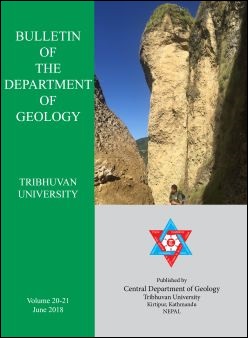Upper Pliocene to Lower Pleistocene Plant Microfossils from The Basal Part of the Lukundol Formation (Southern Kathmandu Valley) and Their Climatic Implications
DOI:
https://doi.org/10.3126/bdg.v20i0.20726Keywords:
Pliocene-Pleistocene, Vegetation, Climate, KathmanduAbstract
The Late Pliocene to Lower Pleistocene fluvio-lacustrine sediments of the Lukundol Formation distributed in the southern part of the Kathmandu Basin, consists of various fossils of flora and fauna which are very useful proxies to reconstruct the past climate. Twenty seven samples were collected for palynological study from different beds of the Lukundol Formation exposed in the Pharsidol area due to recent road cut. The exposure is about 100 m thick. The study revealed the dominance of gymnosperms over angiosperm plants. On the basis of the pollen assemblage, the Lukundol Formation could be divided into three different pollen zones namely PD-I, PD-II and PD-III. The variation in the climate observed in these three zones indicates that the climate of the Kathmandu valley during the deposition of the Lukundol Formation was not uniform. The climate had been warmer in the lower and upper zones while colder in the middle zone than today.
Bulletin of Department of Geology, vol. 20-21, 2018, pp: 71-81
Downloads
Downloads
Published
How to Cite
Issue
Section
License
© Central Department of Geology, Tribhuvan University, Nepal

